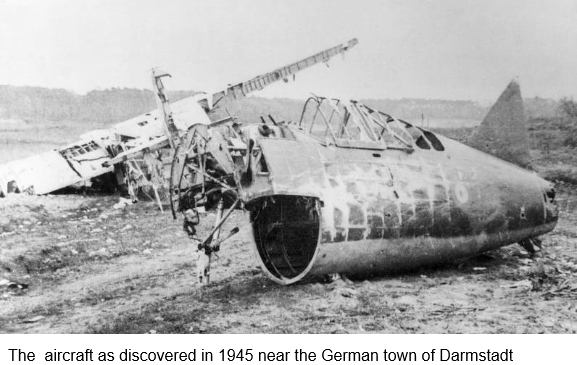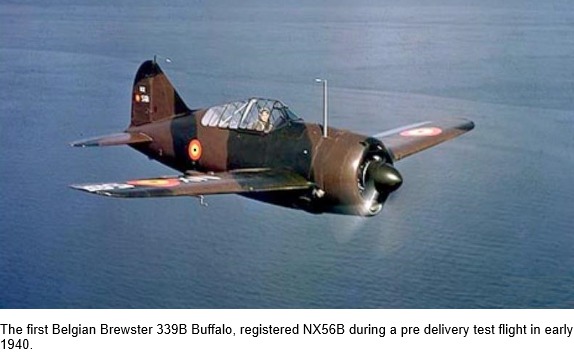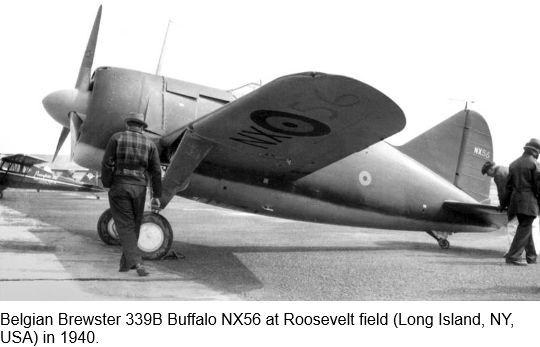| Type |
Single seat fighter |
| Engine |
1 Wright R-1820-40 Cyclone |
| Dimensions |
Length 7,83 m , height 3,66 m , span 10,67 m , wing area 19,40 m2 , |
| Weights |
Empty 2104 kg, loaded 3103 kg , max. take off weight |
| Performance |
Max.. speed 542 km/h, cruising speed 405 km/h , ferry range 2385 km, practical range 1550 km, endurance , service ceiling 9350 m , climb 1092 m/min. |
| Armament |
2 synchronized 12.7-mm Browning AN-M2 machine guns (ammunition - 750 rounds) and two of the same wing machineguns (ammunition - 450
machine guns)
|
| Type |
Werk.Nr |
Registration |
History |
|
56 |
NX56B |
|



With the Munich Crisis of September 1938, most European countries had been confronted with the real threat caused by the expansion plans of Nazi Germany. Most European countries realized that their armies and in particular their Air Forces were certainly no match against the modern equipment of the German Luftwaffe and this kicked off an unprecedented shopping spree for modern combat aircraft.
Belgium which was already in the process of replacing a number of its fighters by “modern” Hurricanes, Gladiators and later Fiat CR-42’s, still operated two fighter squadrons (5/II/2 Aé and 6/III/2 Aé) equipped with the obsolete Fairey Fox VIC (the fighter version of the Fox design). As a small country which was officially still neutral, Belgium could not count on any priority for the delivery of new aerospace equipment. For that reason the government was more than happy to acquire one of the few new aircraft types still available in numbers and in time: the Brewster B-339. The small fighter aircraft was a de-navalized version of the Brewster F2A-1 of the U.S. Navy powered by a Wright Cyclone R-1820-G105 of 1.100hp. On December 11th, 1939 Belgium signed a contract for the delivery of 40 Brewster B-339B's. The first B-339B destined for the Aéronautique Militaire Belge was rolled out of the Brewster plant at Newark in April 1940 and was shipped to Belgium on April 27th, 1940. Overtaken by the events this Brewster, (which had received the temporarily US registration NX56B) was rerouted to Bordeaux in France where it remained boxed and untouched until captured by the Germans. The fact that this particular machine was found at Darmstadt (D.) in 1945 indicates that the Germans at least took interest in this diminutive fighter and most probably have tested it. Meanwhile in the United States production of the Belgian Brewsters continued and 6 moreB 339B's’s were loaded aboard the French aircraft carrier Béarn at Halifax (Can.) on June 16th 1940, to be shipped to France. During this journey, France surrendered on 20 June and the Béarn was ordered to sail to Martinique, where the six Belgian Brewsters together with a large number of aircraft ordered by the French Government were offloaded at Fort-de-France and later placed in storage at La Pointe des Sables. These aircraft were alloted serial numbers 2, 3, 4, 5, 8 and 9. The Belgian Government in exile at London tried to recuperate the equipment but the Vichy regime remained silent. After two years in the tropical air of Martinique the aircraft had to be scrapped only the engines being recuperated. As production continued at Newark, the Belgian Government in London signed a cessation agreement for the 33 remaining aircraft which then were transferred to the Royal Air Force. All aircraft arrived in Britain in July and August 1940, receiving the serials AS410-437, AX810-820 and BB450
The Brewster F2A had a semi-monocoque fuselage with an oval cross-section and very full contours. The wing is single-spar, profile - NACA-230. The sheathing is quite thick everywhere - about 1.5-2.5 mm, working. The aircraft's structure was all-metal, with the exception of the deflectable surfaces, which had a metal frame covered with fabric. The plane was designed to inflated strength standards - this was due to the lack of experience in aviation strength calculations among yesterday's car builders. This explains the congestion of the structure. However, the plane had positive buoyancy and could float for a relatively long time during an emergency landing. The design widely used rivets with a semicircular head to simplify the technology.
The pilot's cabin had no floor; the seat was mounted on an armored frame (armor thickness 7.62 mm). The cockpit canopy was movable, multi-paneled, and provided good visibility, including to the rear. On aircraft operating over the sea, a container with a rescue inflatable boat was attached behind the armored back. The aircraft had a radio station in a compartment behind the armored back.
Propulsion system - 9-cylinder air-cooled Wright "Cyclone" engine, on the first model - XR-1820-G1 (850 hp), on subsequent ones - R-1820-G5 (950 hp) and R-1820 -G40 (1200 hp). The hood is NACA type. The propeller is a three-blade, Hamilton Standard "Hyde-romatic" variable pitch, with a diameter of 2.74 m or 3.12 m, or a Curtiss Electric with a diameter of 3.05 m. A fairing was sometimes installed on the propeller hub, completely or partially covering it.
The main fuel tank was located in front of the cockpit and had a capacity of 143 liters. The wing had compartments in which two more tanks of 130 liters each could be mounted. All tanks were protected and had an inert gas filling system.
The aircraft's landing gear is tricycle, with a tail support. The main landing gear is of an original, not entirely successful design. In the released position, the stand had a V-shape, the load was distributed approximately equally between the stand and the harvesting strut. When retracting, the strut was hydraulically retracted into the fuselage, the strut was retracted into the wing, and the wheel was retracted into the fuselage in a recessed position. The design of the main landing gear was one of the weak points of the aircraft. Its strength was clearly underestimated. The tail support on early machines was non-retractable, self-orienting within 360 degrees, and was equipped with a locking system in the neutral position. On the F2A-2 and -3 series aircraft, the tail support was made retractable. Deck-based aircraft had a cast rubber roller on the tail support; export modifications were equipped with a normal wheel instead.
The drive of the flaps and landing hook is hydraulic. The armament of the production aircraft consisted of two synchronized Browning AN-M2 machine guns of 12.7 mm caliber with 750 rounds of ammunition per barrel. It was possible to install two more of the same machine guns with 450 rounds of ammunition per barrel in the wing when the fuel tanks were removed. Weapon reloading is pneumatic. The sight on early machines is telescopic, on later ones it is collimator. The plane did not have locks for hanging bombs or anti-tank tanks.


